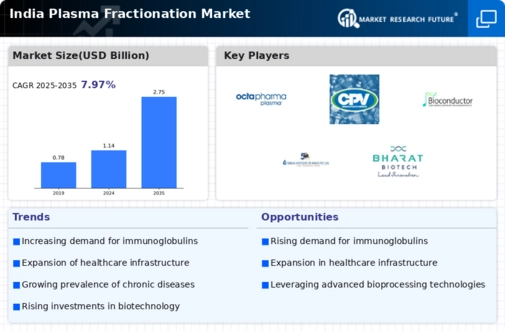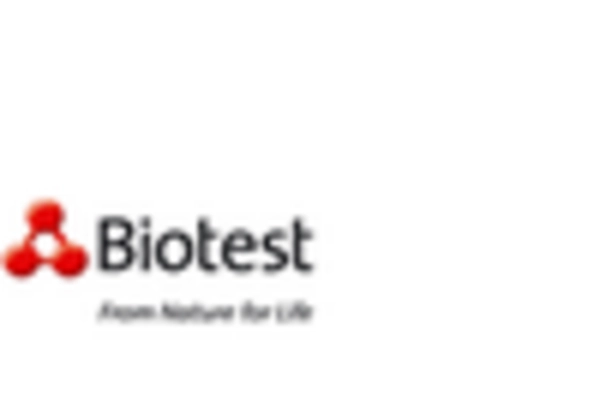Rising Demand for Immunoglobulins
The plasma fractionation market in India is experiencing a notable increase in demand for immunoglobulins, which are critical for treating various immunodeficiency disorders. This surge is driven by a growing awareness of autoimmune diseases and the need for effective therapies. According to recent data, the demand for immunoglobulins is projected to grow at a CAGR of approximately 8% over the next few years. This trend is likely to propel the plasma fractionation market, as manufacturers strive to meet the rising needs of healthcare providers and patients. The increasing prevalence of chronic diseases further emphasizes the necessity for immunoglobulin therapies, thereby enhancing the market's growth potential.
Growing Awareness of Plasma Donation
Growing awareness of the importance of plasma donation is emerging as a crucial driver for the plasma fractionation market in India. Public health campaigns and educational initiatives are encouraging individuals to donate plasma, which is essential for producing life-saving therapies. This increased awareness is likely to enhance the availability of raw plasma, thereby supporting the growth of the plasma fractionation market. Recent surveys indicate that approximately 60% of the population is now aware of the benefits of plasma donation, which is a significant increase compared to previous years. As more individuals participate in donation programs, the supply chain for plasma-derived products is expected to strengthen, ultimately benefiting the market.
Expansion of Healthcare Infrastructure
The expansion of healthcare infrastructure in India is significantly impacting the plasma fractionation market. With the government's focus on improving healthcare access and quality, there has been a substantial increase in the number of hospitals and blood banks equipped to handle plasma collection and processing. This development is expected to enhance the availability of plasma-derived products, thereby driving market growth. Recent reports indicate that the healthcare sector is projected to reach a value of $372 billion by 2022, which suggests a favorable environment for the plasma fractionation market. Enhanced infrastructure not only facilitates better patient care but also encourages investment in advanced fractionation technologies.
Rising Incidence of Hematological Disorders
The rising incidence of hematological disorders in India is contributing to the growth of the plasma fractionation market. Conditions such as hemophilia, thalassemia, and other blood-related disorders require specific plasma-derived therapies for effective management. The increasing prevalence of these disorders is prompting healthcare providers to seek more plasma-derived products, thereby driving market demand. Recent statistics suggest that the incidence of hemophilia in India is approximately 1 in 10,000 males, indicating a substantial patient population that requires ongoing treatment. This trend underscores the critical role of the plasma fractionation market in providing necessary therapies and highlights the potential for future growth as awareness and diagnosis improve.
Increased Research and Development Activities
Increased research and development activities in the field of plasma fractionation are likely to propel the market in India. The focus on developing novel therapies and improving existing plasma-derived products is becoming more pronounced. Institutions and companies are investing in R&D to enhance the efficacy and safety of these products. For instance, the Indian government has allocated substantial funding for biotechnology research, which includes plasma fractionation technologies. This investment is expected to yield innovative solutions that could address unmet medical needs, thereby expanding the plasma fractionation market. The emphasis on R&D may also lead to collaborations between academic institutions and industry players, fostering a more dynamic market environment.

















Leave a Comment